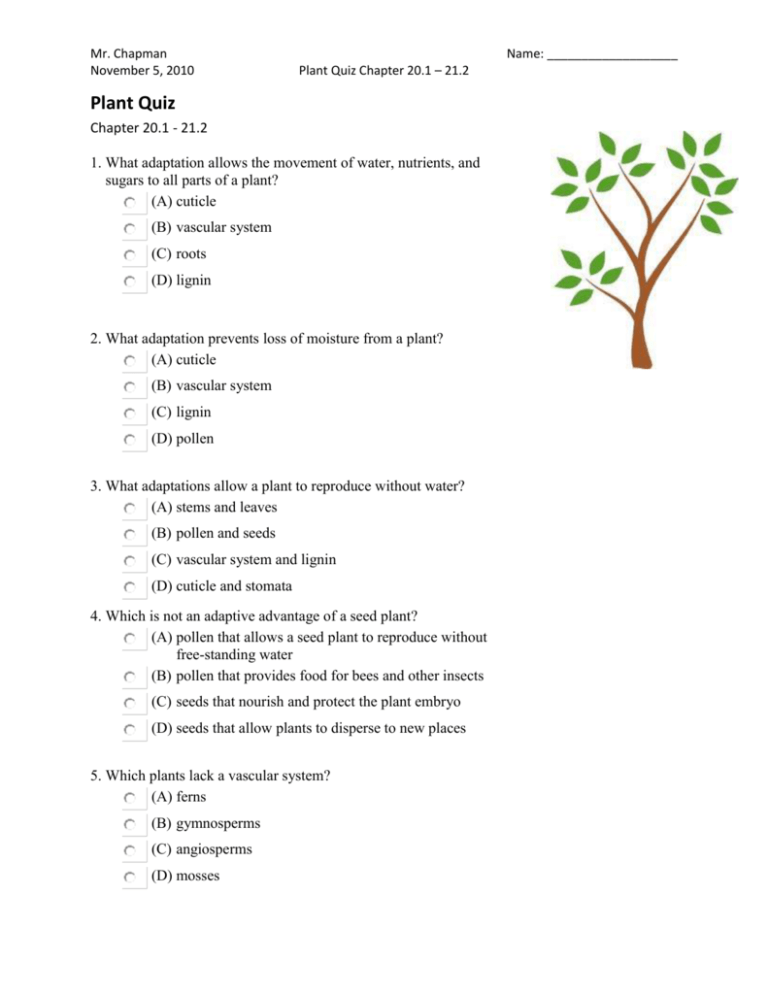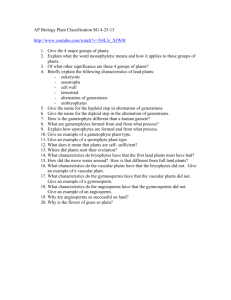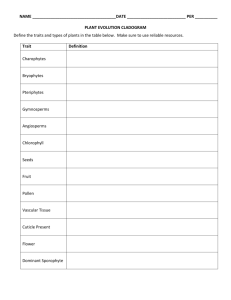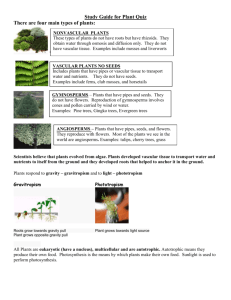Plant Quiz 20.1 - 21.2
advertisement

Mr. Chapman November 5, 2010 Name: ___________________ Plant Quiz Chapter 20.1 – 21.2 Plant Quiz Chapter 20.1 - 21.2 1. What adaptation allows the movement of water, nutrients, and sugars to all parts of a plant? (A) cuticle (B) vascular system (C) roots (D) lignin 2. What adaptation prevents loss of moisture from a plant? (A) cuticle (B) vascular system (C) lignin (D) pollen 3. What adaptations allow a plant to reproduce without water? (A) stems and leaves (B) pollen and seeds (C) vascular system and lignin (D) cuticle and stomata 4. Which is not an adaptive advantage of a seed plant? (A) pollen that allows a seed plant to reproduce without free-standing water (B) pollen that provides food for bees and other insects (C) seeds that nourish and protect the plant embryo (D) seeds that allow plants to disperse to new places 5. Which plants lack a vascular system? (A) ferns (B) gymnosperms (C) angiosperms (D) mosses Mr. Chapman November 5, 2010 Name: ___________________ Plant Quiz Chapter 20.1 – 21.2 6. Which plant group produces fruits? (A) angiosperms (B) gymnosperms (C) cycads (D) conifers 7. Why is pollination in angiosperms more efficient than in gymnosperms? (A) Angiosperms produce more pollen than gymnosperms do. (B) Animals help transfer pollen directly from flower to flower in many angiosperms. (C) Pollen is transferred directly from cone to cone in gymnosperms. (D) Wind is an efficient pollinator. 8. Which flowering-plant group is correctly paired with a characteristic? (A) monocot-flower parts in multiples of four or five (B) monocot-ringed vascular tissue (C) dicot-netlike veins (D) dicot-scattered vascular tissue 9. Which plant cells are strong, contain lignin, and cannot grow with the plant? (A) collenchyma cells (B) sclerenchyma cells (C) ground cells (D) parenchyma cells 10. Which plant tissue has a function similar to an animal's skin? (A) dermal tissue (B) ground tissue (C) vascular tissue (D) plasmodesmata Mr. Chapman November 5, 2010 Name: ___________________ Plant Quiz Chapter 20.1 – 21.2 11. What vascular tissue carries the products of photosynthesis throughout the plant? (A) xylem (B) phloem (C) parenchyma (D) sclerenchyma Section 2: Short Answer Match each term (a plant cell or tissue type) with its proper definition in the table: (6 marks) ____ Parenchyma ____ Dermal ____ Collenchyma ____ Sclerenchyma ____ Ground ____ Vascular a) A strong, flexible cell type found in growing portions of a plant b) The tissue that surrounds the outer portions of a plant c) A tissue that is mainly used for storage within the plant d) Cells that die upon maturity and often form vascular tissue within the plant e) A tissue system containing xylem and phloem, used for transporting materials throughout the plant f) Least specialized type of cell, capable of becoming different types What is a cuticle, and what is its function in a plant? (2 marks) Mr. Chapman November 5, 2010 Name: ___________________ Plant Quiz Chapter 20.1 – 21.2 Bryophytes are seedless, non-vascular plants. Name one advantage (there are more than that) that bryophytes have over other types of plants. (1 mark) List 2 major advantages that seed-bearing plants have over other types of plants. (2 marks) What is the difference between a gymnosperm and an angiosperm? (1 mark) What is the technical definition of a fruit? (1 mark) What is a cotyledon? Explain how monocots and dicots differ in regards to the following three features: veins, multiples of flower parts, vascular tissue. (4 marks)






